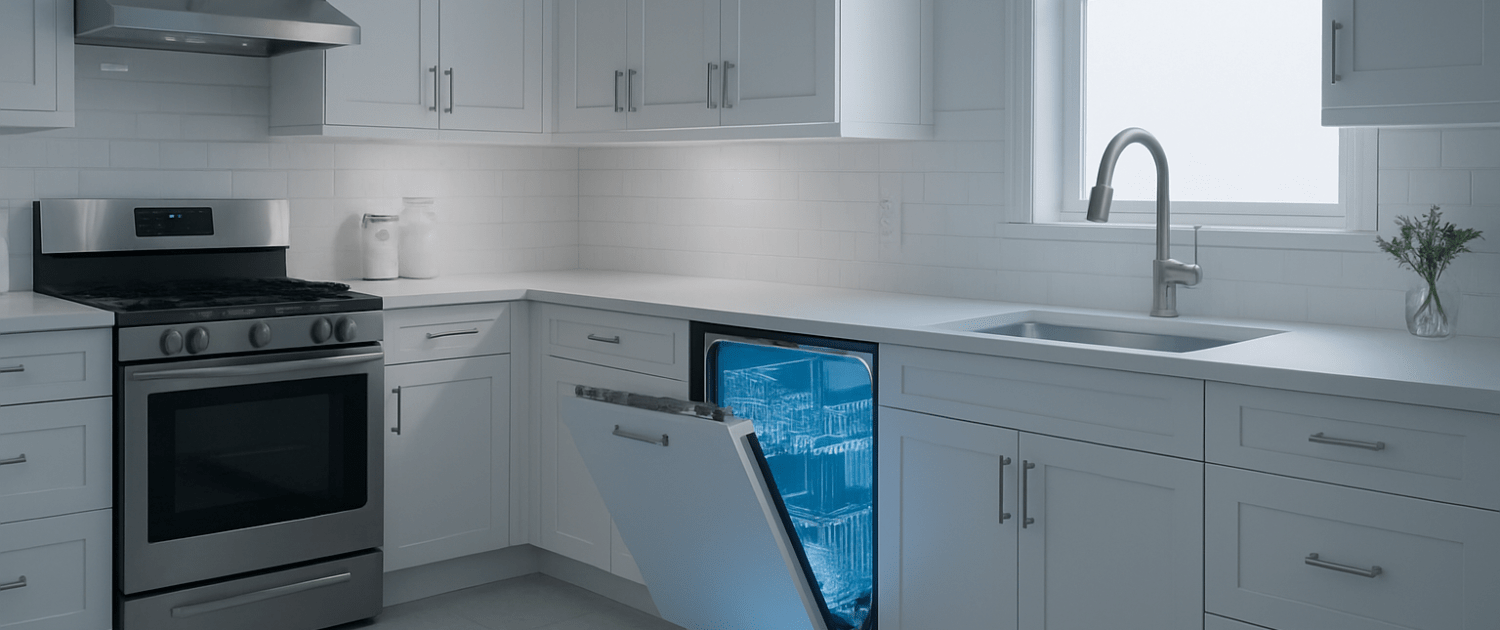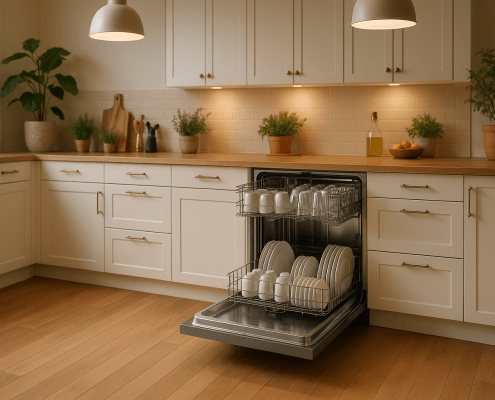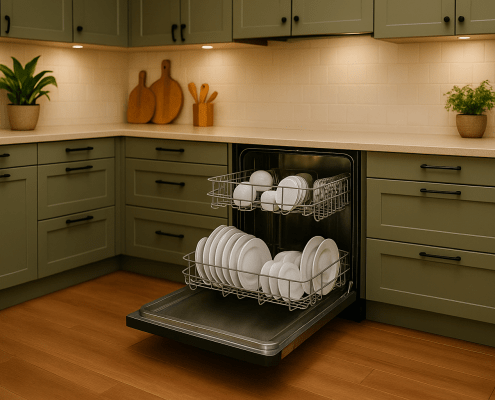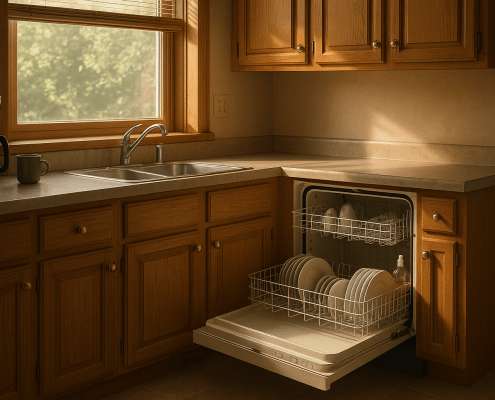How to replace the flood switch WD21X23498 on a GE dishwasher
Steven E / Thursday May 15, 2025
If your GE dishwasher isn’t filling or draining properly, the flood switch WD21X23498 may need to be replaced. This part monitors water levels and prevents flooding from occurring. Replacing it is an easy fix you can do yourself in just a few minutes. We’ll walk through the full step-by-step process of replacing the flood switch.
The information in this article may not apply to your specific appliance model. We recommend consulting your manufacturer’s documentation or contact us with any questions.
Description of the flood switch
The flood switch, also known as a water level switch, is a safety device found on most dishwashers. It’s located at the bottom of the dishwasher tub and monitors water levels during the fill and drain cycles.
If the tub fills too high with water, the flood switch shuts off power to the water inlet valve to stop the flow. This prevents water from overflowing and flooding your kitchen.
Similarly, it prevents the dishwasher from draining completely. If the water level gets too low, the flood switch cuts power to protect the pump from damage.
Over time, flood switches can malfunction or get stuck in the open or closed position. A failed flood switch that doesn’t stop water flow can lead to leakage and flooding. A switch that won’t close and allow proper water filling will prevent your dishwasher from washing dishes properly. Replacing a defective flood switch is an easy and inexpensive do-it-yourself repair. With a few basic tools and safety precautions, you can have your GE dishwasher working again in no time.
Materials needed
For this repair you’ll need:
- Flat blade and Phillips head screwdrivers
- 1⁄4 inch and 5/16 inch nut drivers
- Adjustable wrench
- Replacement flood switch ( part # WD21X23498)
- Towels
Before you start, make sure to turn off the power to the dishwasher at the circuit breaker and turn off the water supply. Have a bucket ready to catch any water that may spill during the repair.
Safety precautions
Safety should always be a priority when working on any appliance. Here are a few practical tips to help you stay safe:
- Turn off the power to the appliance by unplugging it or switching off the circuit breaker before starting any maintenance or repairs. This protects you from the risk of electric shock.
- Wear insulated gloves to shield your hands from sharp edges, pinching hazards, or debris.
- Work at a steady pace and take your time to avoid accidents or injuries.
- Make sure your workspace is well-lit so you can clearly see and access the parts you’re working on.
- Keep the area clear of clutter, and ensure children and pets stay out of the workspace.
- Never handle internal parts with wet hands. Check that both your hands and the work area are completely dry.
- Refer to your appliance’s user manual for any specific instructions or safety guidelines related to the part or repair.
- Handle parts gently to avoid damage to the appliance or potential injuries from applying too much force.
- Use safety glasses when dealing with chemicals, dust, or large debris to protect your eyes from harm.
- If the appliance was recently used, give it enough time to cool down before working on any heated components.
- Take photos or notes of wiring connections and terminals before disconnecting anything to make reassembly easier.
- Avoid touching exposed wires or terminals. If you must handle wires, use non-conductive tools or wear insulated gloves to minimize the risk of electrical shock.
Prep work
- To access the flood switch, we first need to pull the dishwasher out from under the counter.
- Start by laying towels under the dishwasher tub and on the floor in front of it. The towels will soak up any water that leaks out when we disconnect the lines.
- Under the sink, locate the hot water line that runs from the shut-off valve to the dishwasher’s water inlet. Using an adjustable wrench, loosen and disconnect the water line from the valve.
- Next, find the drain hose that runs from the dishwasher to the sink tailpiece or garbage disposal. Loosen the metal hose clamp and disconnect the hose.
- Place a bucket under the connections to catch any water that drips out.
- Open the dishwasher door and pull out the lower rack. Set it aside.
- Under the counter, use a Phillips screwdriver to remove the screws that secure the dishwasher to the cabinet. There are usually two screws along the side walls.
- Carefully pull the dishwasher out a few inches. Reach in and grab the water and drain lines, pulling them through the opening as you continue pulling the dishwasher out.
- Lay the dishwasher on its side on top of the towels.
Replacing the flood switch
With the dishwasher on its side, locating and accessing the flood switch is straightforward.
- A plastic drip pan sits under the dishwasher tub. Remove it by sliding it outward and lifting it up. Set the drip pan aside.
- Look on the bottom of the dishwasher tub to find a square plastic housing mounted to the sump. This contains the flood switch.
- Use a 1/4-inch nut driver to remove the screw from the center of the flood switch housing.
- The screw secures the switch wires. Note which wire connects to each of the two switch terminals – the wires must be reinstalled on the correct terminals.
- Carefully detach the wires from the old switch. There will be a wire with an orange casing and another with red and white stripes.
- On each side of the plastic housing are plastic locking tabs. Insert a small flat-blade screwdriver into the slots and gently pry up the tabs to release the switch.
- You can now lift the defective flood switch out of the housing.
- First, align the new OEM replacement flood switch into the plastic housing. Push it down until it clicks into place.
- Reattach the wires to the proper terminals – orange to the lower terminal, red and white to the upper.
- Insert the center screw and tighten it with the nut driver to secure the wires.
- Carefully align the drip pan front lip over the tub edge. Push it in slightly, then slide it backward to lock the side tabs into place.
Finishing up
With the new flood switch installed, we can reinstall the dishwasher.
- Lift the dishwasher back up onto its feet. Push it about halfway back into the cabinet opening.
- Reach in and grab the water and drain lines. Pull them through as you push the dishwasher fully back into the cabinet.
- Connect the drain hose to the sink tailpiece or disposal and tighten the hose clamp.
- Attach the water line to the hot water valve. Make sure the rubber washer is seated properly, then tighten it with an adjustable wrench.
- Open the dishwasher door. Insert and tighten the screws along the side walls to secure the dishwasher to the cabinet.
- Replace the lower rack by sliding it back into place on the door.
- With everything back in place, turn on the water supply and power.
- Run a test cycle to verify the dishwasher fills, washes, and drains properly. Check under the dishwasher to make sure there are no leaks.
- Be sure to grab a towel and wipe up any water that may have dripped out during the repair.
Where To Find Us
If you need any replacement parts for your appliances, you can enter your model number at AppliancePartsPros.com to locate and order them quickly. Most orders arrive in just two business days, and we have tons of great information in our repair help section and YouTube videos to help you troubleshoot.
Stay connected with the latest DIY tips, tutorial videos, and repair guides by following us on Facebook, Instagram, and Twitter. We love hearing about your repair stories and successes. If you need more help or want personalized guidance, feel free to reach out. We’re ready to help you take on your next project with confidence!
With nearly a decade of experience in providing top-notch customer service regarding appliance parts and repair, Steven enjoys sharing practical advice, troubleshooting tips, and interesting information to help readers stay informed.





